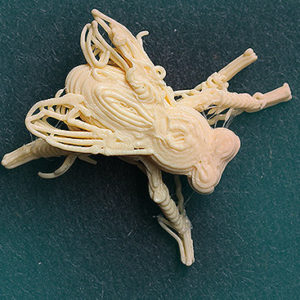Stereolithography / 3D Printing / Additive Fabrication/ Additive Manufacturing
 Stereolithography is an imaging process in three dimensions. Some synonyms used for stereolithography include 3D printing, optical fabrication, photosolidification, solid freeform fabrication, solid imaging, optical shaping, steric polymerization, desk-top manufacturing, additive manufacturing, automatic modeling, electron beam melting, digital part materialization, freeforming etc. Besides 3D printing, commonly accepted term for this process is additive manufacturing (AM). We prefer the term “additive fabrication” since manufacturing connotes mass production and current 3D printing is anything but that.
Stereolithography is an imaging process in three dimensions. Some synonyms used for stereolithography include 3D printing, optical fabrication, photosolidification, solid freeform fabrication, solid imaging, optical shaping, steric polymerization, desk-top manufacturing, additive manufacturing, automatic modeling, electron beam melting, digital part materialization, freeforming etc. Besides 3D printing, commonly accepted term for this process is additive manufacturing (AM). We prefer the term “additive fabrication” since manufacturing connotes mass production and current 3D printing is anything but that.
The U.S. Patent 2,775,758 issued to John Munz in 1956 disclosed a process to produce three-dimensional reproductions using a light-sensitive “emulsion” in a container. The process was referred to as “photo-glyph recording”. In 1950s and 1960s, DuPont Company was awarded a number of patents for making solid printing plates using a variety of photopolymers and UV light exposure. Subsequently, a number of inventors attempted to make solid objects using photopolymers and UV lasers. However, it was Charles W. Hull who commercialized his invention in 1980s by setting up 3D Systems
The term “stereolithography” was coined by Chuck Hull, in his US Patent 4,575,330, entitled “Apparatus for Production of Three-Dimensional Objects by Stereolithography” issued in 1986. Stereolithography was defined as a method and apparatus for making solid objects by successively “printing” thin layers of the curable material, e.g., a UV-curable material, one on top of the other.
In Hull’s patent, a concentrated beam of ultraviolet light is focused onto the surface of a vat filled with liquid photopolymer. The light beam, moving under computer control, draws each layer of the object onto the surface of the liquid. Wherever the beam strikes the surface, the photopolymer polymerizes/crosslinks and changes to a solid. An advanced CAD/CAM/CAE software mathematically slices the computer model of the object into a large number of thin layers. The process then builds the object layer by layer starting with the bottom layer, on an elevator that is lowered slightly after solidification of each layer.
A process called DLP (digital light processing) is now widely used in desktop printers for liquid resins. In this technology, a light projector screen is used to photopolymerize a layer at a time instead of a point at a time as in Hull’s patent. The projected image is generated by a digital micro-mirror device in a chip. A typical printer uses a liquid photopolymer tank with transparent bottom to create parts upside down layer-wise.
The owner of this website has discovered a modified stereolithographic process in additive manufacturing which he calls “Dry Stereolithography” (DSL). He was granted the US patent 11,052,599 for the same in July 2021. He gave a presentation on the process at the 2023 Annual Technical Conference of the Society of Plastics Engineers in Denver, CO. Raw materials for the process are based on dry thermoplastic photopolymers that are cost-competitive to liquid photopolymer resins. These dry photopolymers are in the form of environmentally safe film or sheet/plate between a transparent support film and a release film.
Non-photopolymer-based rapid prototyping processes include fusion deposition modeling (FDM®), laser sintering, an inkjet system, electron beam melting and Arburg Plastic Freeforming. The FDM process developed by Stratasys extrudes a thin thermoplastic filament layer by layer. Laser sintering process uses data from a CAD/CAM/CAE system and laser technology to transform a variety of powdered materials into three-dimensional prototypes. Selective laser sintering (SLS ®) involves the use of a high power laser to fuse small particles of plastics, metal, ceramic or glass powders into a solid object. An inkjet equipment marketed by Z Corp. (now part of 3D Systems) builds models by depositing a binder solution through an inkjet print head onto layers of a plaster-based powder. A US company has developed a desk top 3D printer using liquid metal jet printing technology. Objet Geomeries’ (now merged with Stratasys) 3D printers use inkjetters of photopolymers. In laminated object manufacturing (LOM), layers of adhesive-coated paper, plastics or metal laminates are successively bonded together and cut to shape with a knife or a laser.
A variety of liquid photopolymers are available for stereolithography. Epoxy-based systems and hybrids are now preferred to older acrylates because of former’s higher green strength, higher temperature resistance, lower moisture absorption and lower shrinkage. Radiation-cured acrylates also suffer from oxygen inhibition. The hybrids cure under light by cationic as well as free radical polymerization. Photopolymer resins with mechanical properties similar to engineering plastics such as ABS, nylon and polycarbonate are available.
Besides rapid prototyping, 3D printing is now used for rapid manufacturing of small production runs. Both photopolymer-based as well as non-photopolymer-based processes are now used for short run manufacturing. A proliferation of 3d printer manufacturers has made printers now available for DIY-ers, teachers, artists, hobbyists and consumers. A list of photopolymer-based printer manufacturers, large and small, include those shown below:
Photopolymer 3D Printer Manufacturers
3D Systems, USA
Anycubic, China
Asiga, Australia
B9Creations, USA
Carbon 3D, USA
CoLiDo, HongKong
Cubicure, Austria
Flashforge, USA
Formlabs, USA
Leopoly, Hungary
Lumi Industries, Italy
Photocentric, U.K.
Phrozen, Taiwan
SprintRay, USA
Stratasys, USA
Structo, Singapore
Uniz, USA
Wanhao, China
XYZprinting, Taiwan
Photopolymer producers for 3D printers include the following:
Producers of Liquid Photopolymer Resins for 3D Printing
3D Systems, USA
Adaptive 3D Technologies, USA
ApplyLabWork, USA
BASF 3D Printing Solutions, Germany
Chemence, USA
DSM Additive Manufacturing, USA
Formlabs, USA
MakerJuice Labs, USA
Molecule, USA
Photocentric, U.K.

